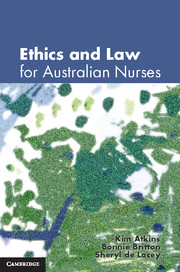Book contents
- Frontmatter
- Contents
- Introduction
- 1 Understanding the human person
- 2 Understanding legal rights and obligations
- 3 Nursing and the legal system
- 4 The nurse–patient relationship
- 5 Consent
- 6 Duty of care and professional negligence
- 7 Patient information, confidentiality and trust
- 8 ‘Trust me, I’m a nurse’
- 9 Witnessing and making mistakes
- Appendix: Tables of legislation
- References
- Index
Introduction
- Frontmatter
- Contents
- Introduction
- 1 Understanding the human person
- 2 Understanding legal rights and obligations
- 3 Nursing and the legal system
- 4 The nurse–patient relationship
- 5 Consent
- 6 Duty of care and professional negligence
- 7 Patient information, confidentiality and trust
- 8 ‘Trust me, I’m a nurse’
- 9 Witnessing and making mistakes
- Appendix: Tables of legislation
- References
- Index
Summary
This book has been written specifically for nurses training and practising within Australia, to assist and encourage them to develop a strong and well-defined sense of professional and moral identity. It endeavours to provide an integrated, practical framework for understanding the ethical and legal dimensions of nursing practice in Australia by referencing Australian law and reflecting the Australian clinical context and cultural norms.
This book refers to ‘patients’ rather than ‘clients’. The question of which term is most appropriate is not easily resolved – if it can be at all – because there are many ways to interpret both terms. Consequently, we have made the decision to use the term ‘patients’ because it best approximates our use of the concept of vulnerability. We do not regard patients as people who are either in a contract with the nurse or merely passive and dependent on the nurse; rather, patients are people who are in a relationship of power with the nurse because they are in specific situations of need. Under Australian law, this is considered a fiduciary relationship – that is, one in which the nurse is recognised as having superior knowledge and therefore more power than the patient, but the patient's authority in decision-making carries more legal and moral force. To represent patients as people who have a merely contractual or dependency relationship with a nurse would be to misrepresent their situation and to obscure the ethical and moral implications of the context of care. A patient's need and vulnerability in the context of a nurse's power constitute the source of the nurse's moral and legal obligations. Therefore, throughout this book the nurse–patient relationship occupies centre stage.
- Type
- Chapter
- Information
- Ethics and Law for Australian Nurses , pp. 1 - 6Publisher: Cambridge University PressPrint publication year: 2011

